Change and Transformation: A Report on Jobs International India Ltd
VerifiedAdded on 2021/07/07
|18
|3988
|63
Report
AI Summary
This report examines the change management challenges faced by Jobs International India Ltd., a subsidiary of Jobs International UK Ltd. The analysis focuses on the application of change management theories and models, particularly McKinsey's 7S model, to address issues arising from a new managing director and cultural differences within the organization. The report provides recommendations for the consultant on how to navigate the situation, including strategies for overcoming obstacles such as cultural clashes, fear of change, and employee resistance. It explores the actions Mr. Jacobs should take, emphasizing the importance of communication, training, and strategic direction. The report also discusses the limitations of the models used and offers an action plan for business expansion, considering potential obstacles and solutions to ensure successful implementation of change initiatives. Overall, the report highlights the importance of effective leadership, employee engagement, and a proactive approach to organizational transformation.
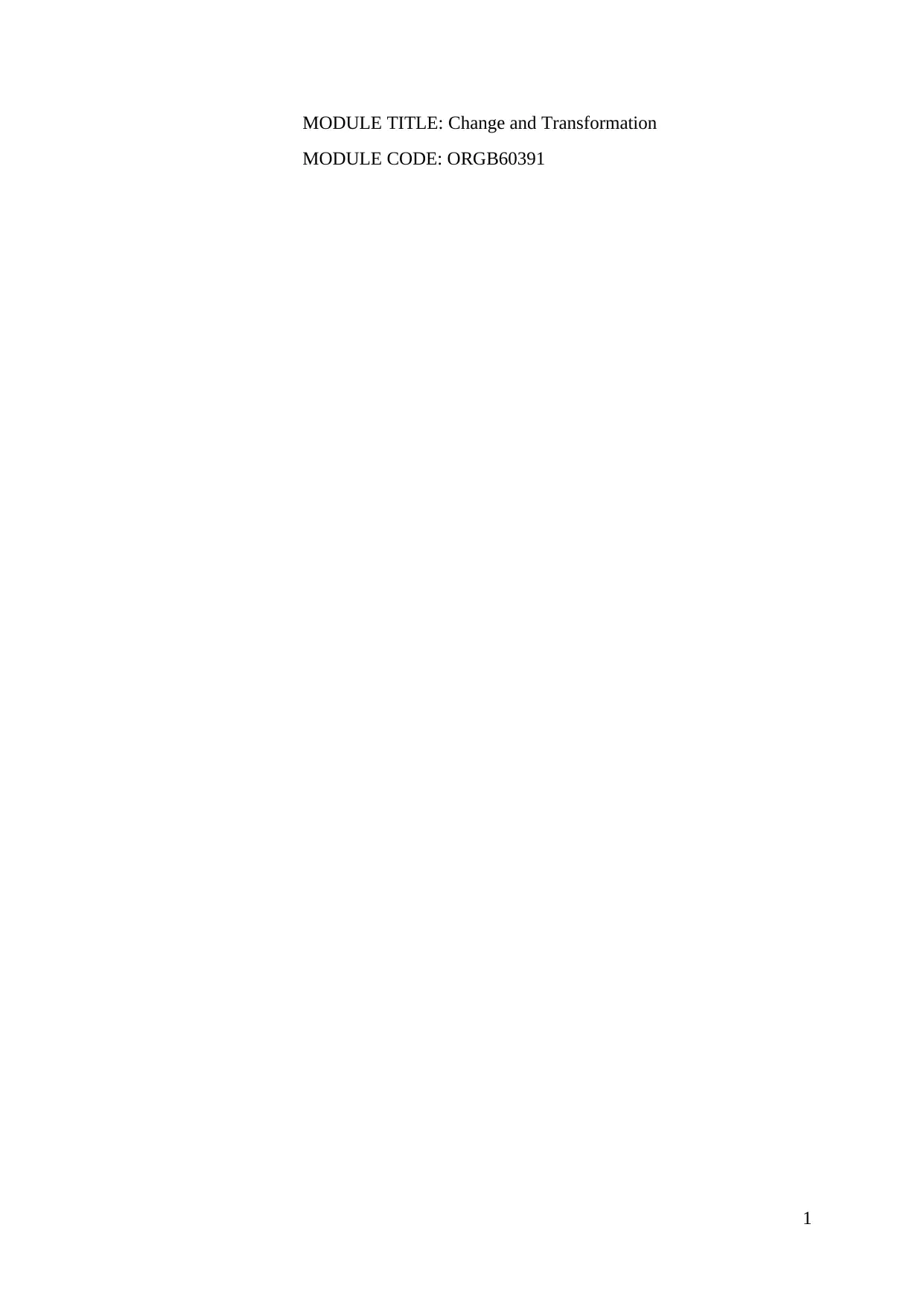
MODULE TITLE: Change and Transformation
MODULE CODE: ORGB60391
1
MODULE CODE: ORGB60391
1
Paraphrase This Document
Need a fresh take? Get an instant paraphrase of this document with our AI Paraphraser
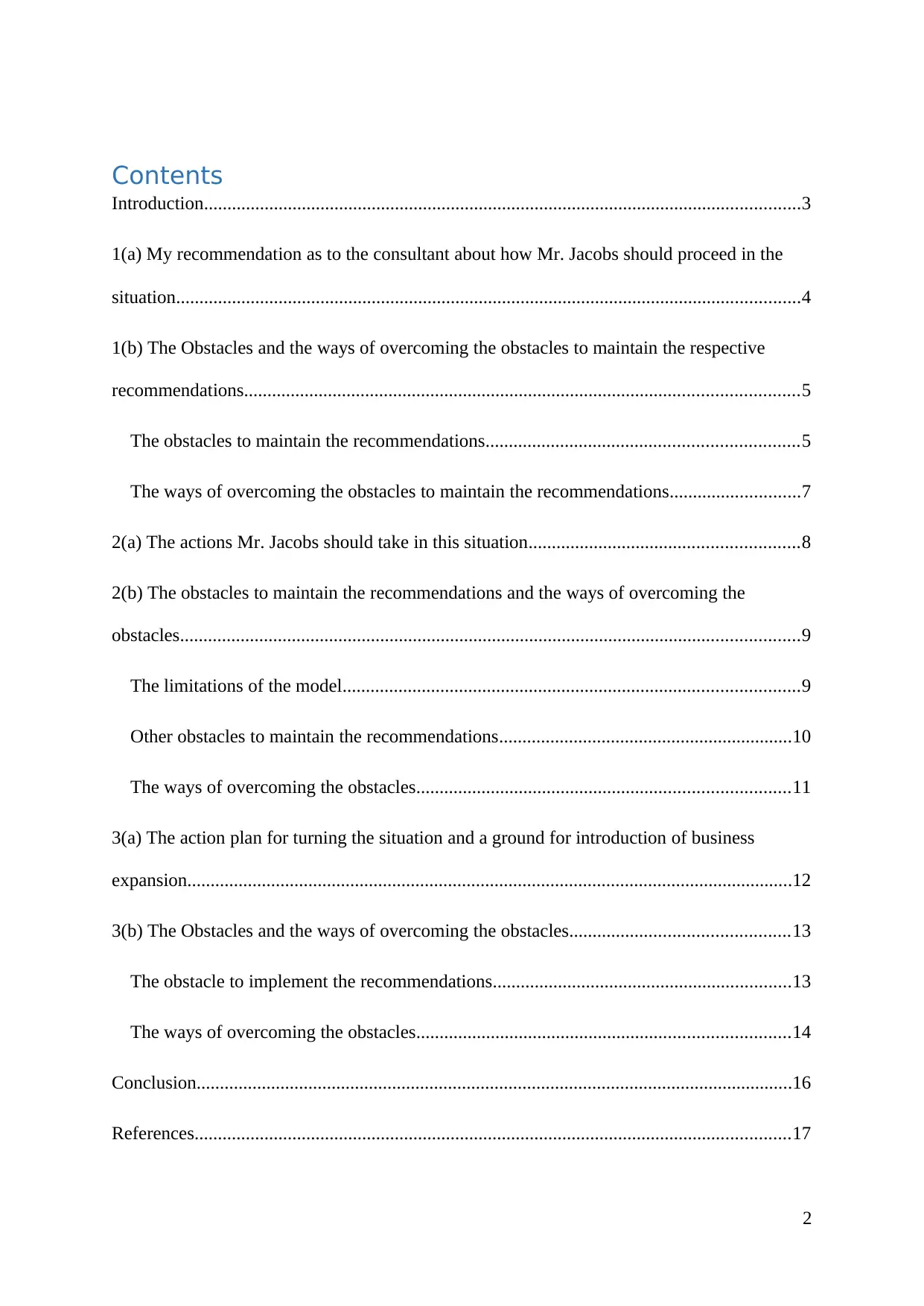
Contents
Introduction................................................................................................................................3
1(a) My recommendation as to the consultant about how Mr. Jacobs should proceed in the
situation......................................................................................................................................4
1(b) The Obstacles and the ways of overcoming the obstacles to maintain the respective
recommendations.......................................................................................................................5
The obstacles to maintain the recommendations...................................................................5
The ways of overcoming the obstacles to maintain the recommendations............................7
2(a) The actions Mr. Jacobs should take in this situation..........................................................8
2(b) The obstacles to maintain the recommendations and the ways of overcoming the
obstacles.....................................................................................................................................9
The limitations of the model..................................................................................................9
Other obstacles to maintain the recommendations...............................................................10
The ways of overcoming the obstacles................................................................................11
3(a) The action plan for turning the situation and a ground for introduction of business
expansion..................................................................................................................................12
3(b) The Obstacles and the ways of overcoming the obstacles...............................................13
The obstacle to implement the recommendations................................................................13
The ways of overcoming the obstacles................................................................................14
Conclusion................................................................................................................................16
References................................................................................................................................17
2
Introduction................................................................................................................................3
1(a) My recommendation as to the consultant about how Mr. Jacobs should proceed in the
situation......................................................................................................................................4
1(b) The Obstacles and the ways of overcoming the obstacles to maintain the respective
recommendations.......................................................................................................................5
The obstacles to maintain the recommendations...................................................................5
The ways of overcoming the obstacles to maintain the recommendations............................7
2(a) The actions Mr. Jacobs should take in this situation..........................................................8
2(b) The obstacles to maintain the recommendations and the ways of overcoming the
obstacles.....................................................................................................................................9
The limitations of the model..................................................................................................9
Other obstacles to maintain the recommendations...............................................................10
The ways of overcoming the obstacles................................................................................11
3(a) The action plan for turning the situation and a ground for introduction of business
expansion..................................................................................................................................12
3(b) The Obstacles and the ways of overcoming the obstacles...............................................13
The obstacle to implement the recommendations................................................................13
The ways of overcoming the obstacles................................................................................14
Conclusion................................................................................................................................16
References................................................................................................................................17
2
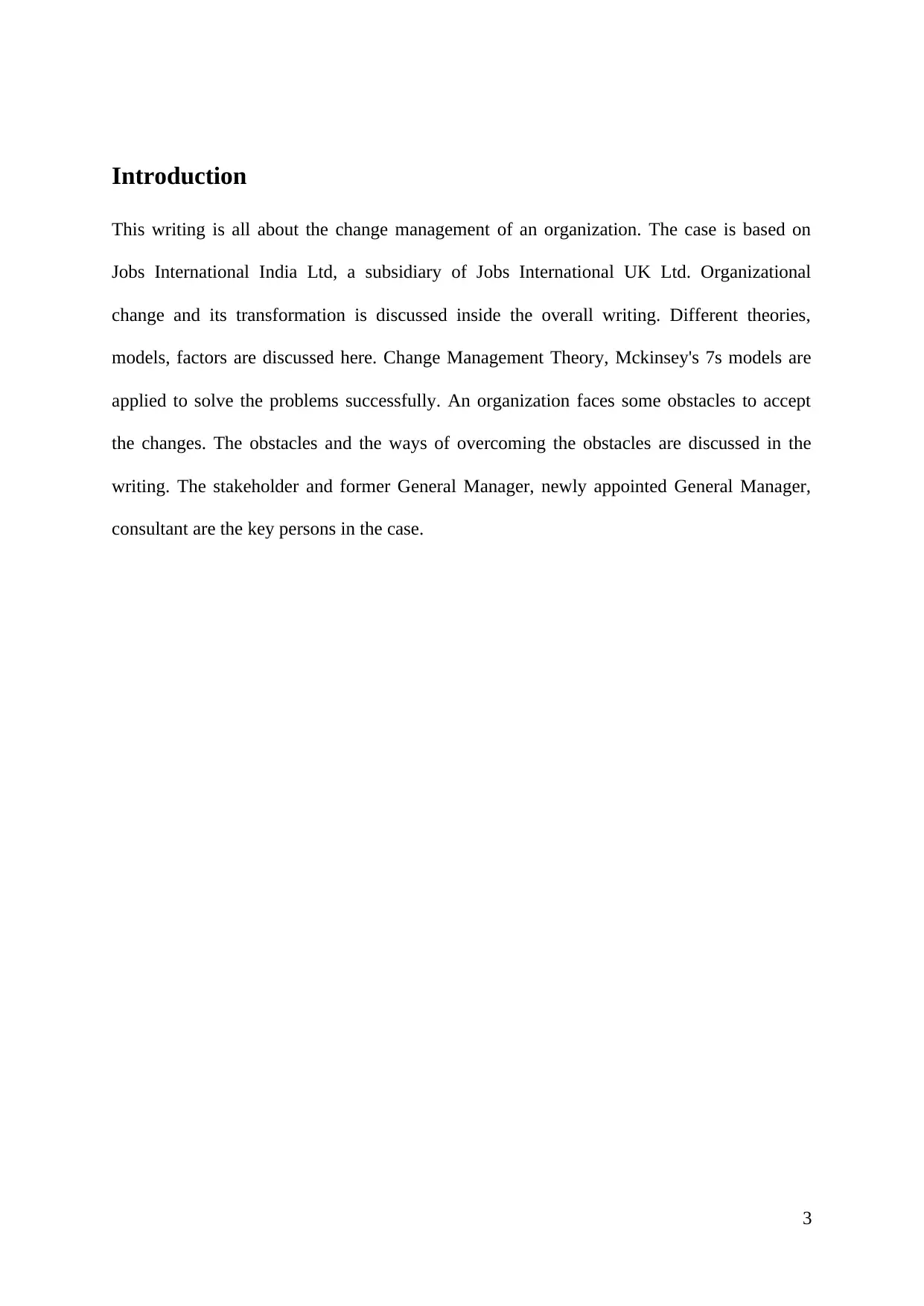
Introduction
This writing is all about the change management of an organization. The case is based on
Jobs International India Ltd, a subsidiary of Jobs International UK Ltd. Organizational
change and its transformation is discussed inside the overall writing. Different theories,
models, factors are discussed here. Change Management Theory, Mckinsey's 7s models are
applied to solve the problems successfully. An organization faces some obstacles to accept
the changes. The obstacles and the ways of overcoming the obstacles are discussed in the
writing. The stakeholder and former General Manager, newly appointed General Manager,
consultant are the key persons in the case.
3
This writing is all about the change management of an organization. The case is based on
Jobs International India Ltd, a subsidiary of Jobs International UK Ltd. Organizational
change and its transformation is discussed inside the overall writing. Different theories,
models, factors are discussed here. Change Management Theory, Mckinsey's 7s models are
applied to solve the problems successfully. An organization faces some obstacles to accept
the changes. The obstacles and the ways of overcoming the obstacles are discussed in the
writing. The stakeholder and former General Manager, newly appointed General Manager,
consultant are the key persons in the case.
3
⊘ This is a preview!⊘
Do you want full access?
Subscribe today to unlock all pages.

Trusted by 1+ million students worldwide
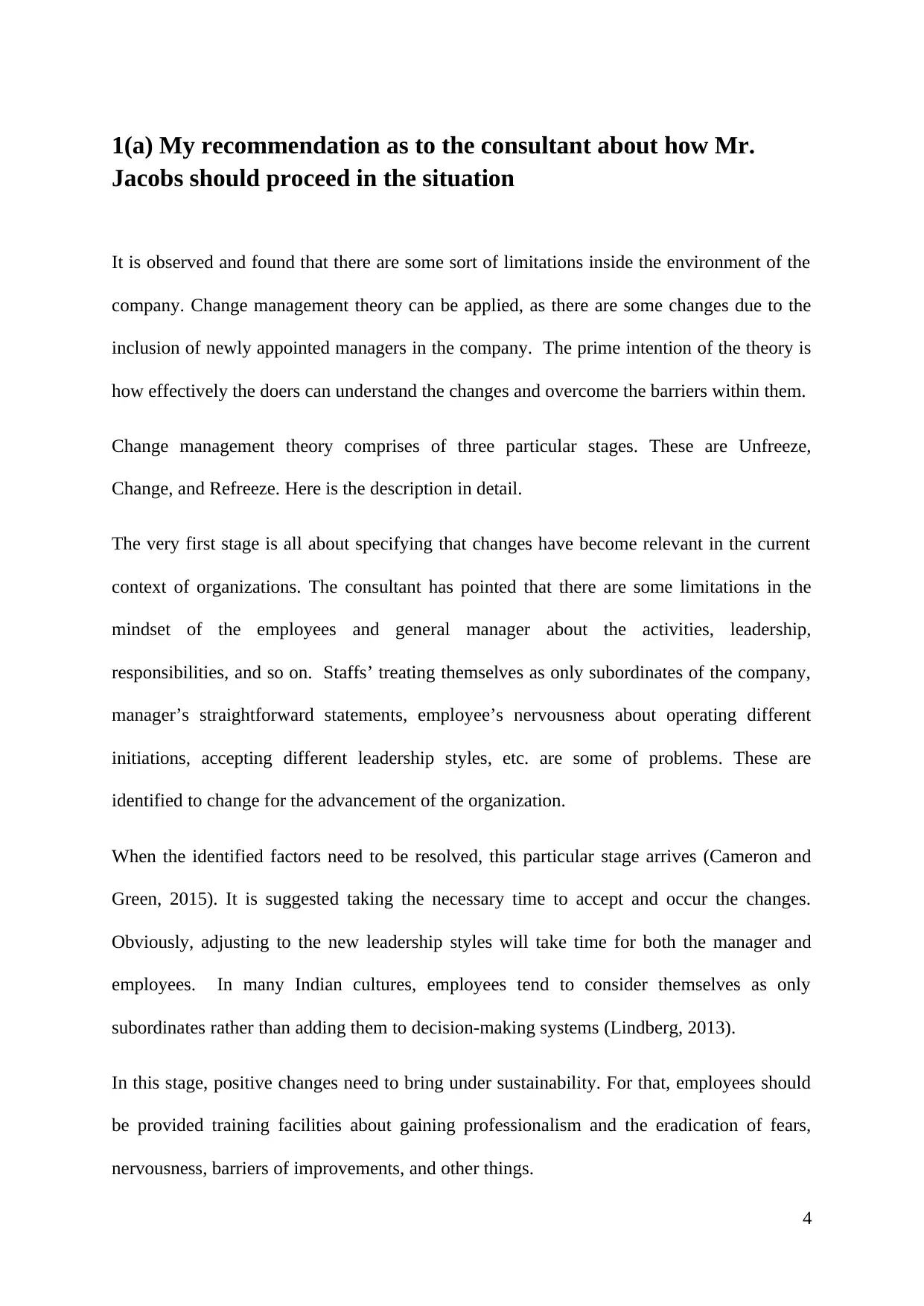
1(a) My recommendation as to the consultant about how Mr.
Jacobs should proceed in the situation
It is observed and found that there are some sort of limitations inside the environment of the
company. Change management theory can be applied, as there are some changes due to the
inclusion of newly appointed managers in the company. The prime intention of the theory is
how effectively the doers can understand the changes and overcome the barriers within them.
Change management theory comprises of three particular stages. These are Unfreeze,
Change, and Refreeze. Here is the description in detail.
The very first stage is all about specifying that changes have become relevant in the current
context of organizations. The consultant has pointed that there are some limitations in the
mindset of the employees and general manager about the activities, leadership,
responsibilities, and so on. Staffs’ treating themselves as only subordinates of the company,
manager’s straightforward statements, employee’s nervousness about operating different
initiations, accepting different leadership styles, etc. are some of problems. These are
identified to change for the advancement of the organization.
When the identified factors need to be resolved, this particular stage arrives (Cameron and
Green, 2015). It is suggested taking the necessary time to accept and occur the changes.
Obviously, adjusting to the new leadership styles will take time for both the manager and
employees. In many Indian cultures, employees tend to consider themselves as only
subordinates rather than adding them to decision-making systems (Lindberg, 2013).
In this stage, positive changes need to bring under sustainability. For that, employees should
be provided training facilities about gaining professionalism and the eradication of fears,
nervousness, barriers of improvements, and other things.
4
Jacobs should proceed in the situation
It is observed and found that there are some sort of limitations inside the environment of the
company. Change management theory can be applied, as there are some changes due to the
inclusion of newly appointed managers in the company. The prime intention of the theory is
how effectively the doers can understand the changes and overcome the barriers within them.
Change management theory comprises of three particular stages. These are Unfreeze,
Change, and Refreeze. Here is the description in detail.
The very first stage is all about specifying that changes have become relevant in the current
context of organizations. The consultant has pointed that there are some limitations in the
mindset of the employees and general manager about the activities, leadership,
responsibilities, and so on. Staffs’ treating themselves as only subordinates of the company,
manager’s straightforward statements, employee’s nervousness about operating different
initiations, accepting different leadership styles, etc. are some of problems. These are
identified to change for the advancement of the organization.
When the identified factors need to be resolved, this particular stage arrives (Cameron and
Green, 2015). It is suggested taking the necessary time to accept and occur the changes.
Obviously, adjusting to the new leadership styles will take time for both the manager and
employees. In many Indian cultures, employees tend to consider themselves as only
subordinates rather than adding them to decision-making systems (Lindberg, 2013).
In this stage, positive changes need to bring under sustainability. For that, employees should
be provided training facilities about gaining professionalism and the eradication of fears,
nervousness, barriers of improvements, and other things.
4
Paraphrase This Document
Need a fresh take? Get an instant paraphrase of this document with our AI Paraphraser
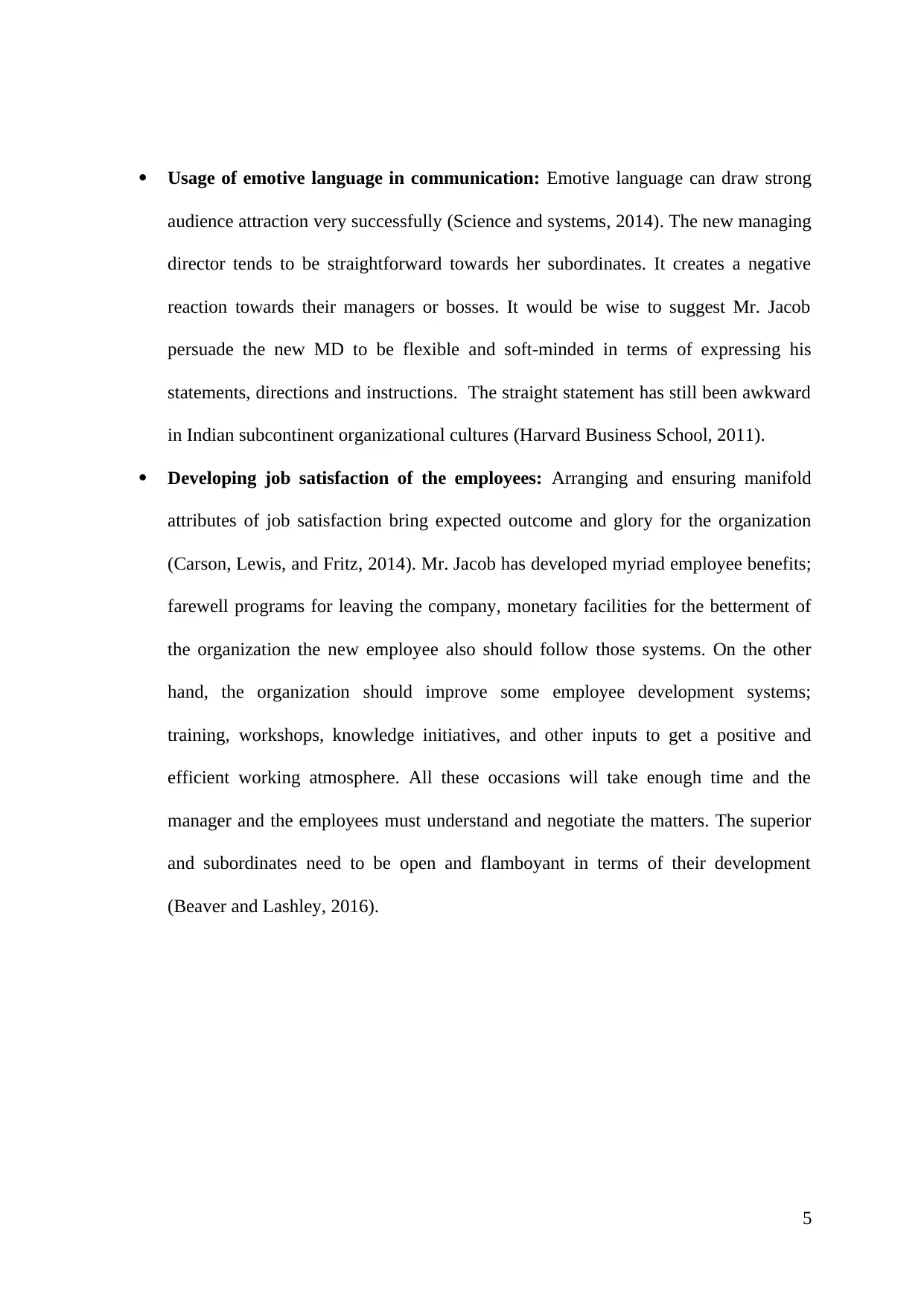
Usage of emotive language in communication: Emotive language can draw strong
audience attraction very successfully (Science and systems, 2014). The new managing
director tends to be straightforward towards her subordinates. It creates a negative
reaction towards their managers or bosses. It would be wise to suggest Mr. Jacob
persuade the new MD to be flexible and soft-minded in terms of expressing his
statements, directions and instructions. The straight statement has still been awkward
in Indian subcontinent organizational cultures (Harvard Business School, 2011).
Developing job satisfaction of the employees: Arranging and ensuring manifold
attributes of job satisfaction bring expected outcome and glory for the organization
(Carson, Lewis, and Fritz, 2014). Mr. Jacob has developed myriad employee benefits;
farewell programs for leaving the company, monetary facilities for the betterment of
the organization the new employee also should follow those systems. On the other
hand, the organization should improve some employee development systems;
training, workshops, knowledge initiatives, and other inputs to get a positive and
efficient working atmosphere. All these occasions will take enough time and the
manager and the employees must understand and negotiate the matters. The superior
and subordinates need to be open and flamboyant in terms of their development
(Beaver and Lashley, 2016).
5
audience attraction very successfully (Science and systems, 2014). The new managing
director tends to be straightforward towards her subordinates. It creates a negative
reaction towards their managers or bosses. It would be wise to suggest Mr. Jacob
persuade the new MD to be flexible and soft-minded in terms of expressing his
statements, directions and instructions. The straight statement has still been awkward
in Indian subcontinent organizational cultures (Harvard Business School, 2011).
Developing job satisfaction of the employees: Arranging and ensuring manifold
attributes of job satisfaction bring expected outcome and glory for the organization
(Carson, Lewis, and Fritz, 2014). Mr. Jacob has developed myriad employee benefits;
farewell programs for leaving the company, monetary facilities for the betterment of
the organization the new employee also should follow those systems. On the other
hand, the organization should improve some employee development systems;
training, workshops, knowledge initiatives, and other inputs to get a positive and
efficient working atmosphere. All these occasions will take enough time and the
manager and the employees must understand and negotiate the matters. The superior
and subordinates need to be open and flamboyant in terms of their development
(Beaver and Lashley, 2016).
5
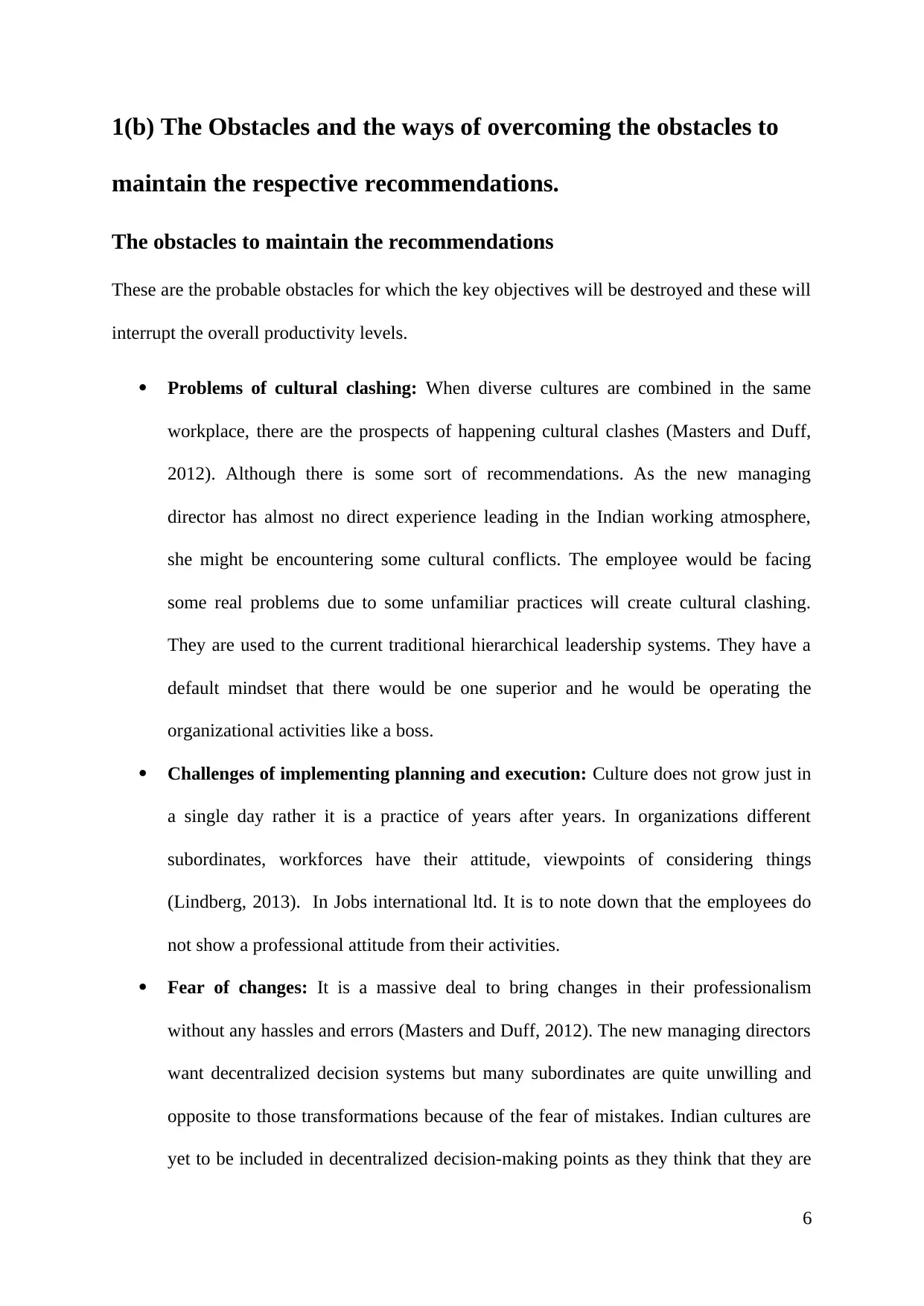
1(b) The Obstacles and the ways of overcoming the obstacles to
maintain the respective recommendations.
The obstacles to maintain the recommendations
These are the probable obstacles for which the key objectives will be destroyed and these will
interrupt the overall productivity levels.
Problems of cultural clashing: When diverse cultures are combined in the same
workplace, there are the prospects of happening cultural clashes (Masters and Duff,
2012). Although there is some sort of recommendations. As the new managing
director has almost no direct experience leading in the Indian working atmosphere,
she might be encountering some cultural conflicts. The employee would be facing
some real problems due to some unfamiliar practices will create cultural clashing.
They are used to the current traditional hierarchical leadership systems. They have a
default mindset that there would be one superior and he would be operating the
organizational activities like a boss.
Challenges of implementing planning and execution: Culture does not grow just in
a single day rather it is a practice of years after years. In organizations different
subordinates, workforces have their attitude, viewpoints of considering things
(Lindberg, 2013). In Jobs international ltd. It is to note down that the employees do
not show a professional attitude from their activities.
Fear of changes: It is a massive deal to bring changes in their professionalism
without any hassles and errors (Masters and Duff, 2012). The new managing directors
want decentralized decision systems but many subordinates are quite unwilling and
opposite to those transformations because of the fear of mistakes. Indian cultures are
yet to be included in decentralized decision-making points as they think that they are
6
maintain the respective recommendations.
The obstacles to maintain the recommendations
These are the probable obstacles for which the key objectives will be destroyed and these will
interrupt the overall productivity levels.
Problems of cultural clashing: When diverse cultures are combined in the same
workplace, there are the prospects of happening cultural clashes (Masters and Duff,
2012). Although there is some sort of recommendations. As the new managing
director has almost no direct experience leading in the Indian working atmosphere,
she might be encountering some cultural conflicts. The employee would be facing
some real problems due to some unfamiliar practices will create cultural clashing.
They are used to the current traditional hierarchical leadership systems. They have a
default mindset that there would be one superior and he would be operating the
organizational activities like a boss.
Challenges of implementing planning and execution: Culture does not grow just in
a single day rather it is a practice of years after years. In organizations different
subordinates, workforces have their attitude, viewpoints of considering things
(Lindberg, 2013). In Jobs international ltd. It is to note down that the employees do
not show a professional attitude from their activities.
Fear of changes: It is a massive deal to bring changes in their professionalism
without any hassles and errors (Masters and Duff, 2012). The new managing directors
want decentralized decision systems but many subordinates are quite unwilling and
opposite to those transformations because of the fear of mistakes. Indian cultures are
yet to be included in decentralized decision-making points as they think that they are
6
⊘ This is a preview!⊘
Do you want full access?
Subscribe today to unlock all pages.

Trusted by 1+ million students worldwide
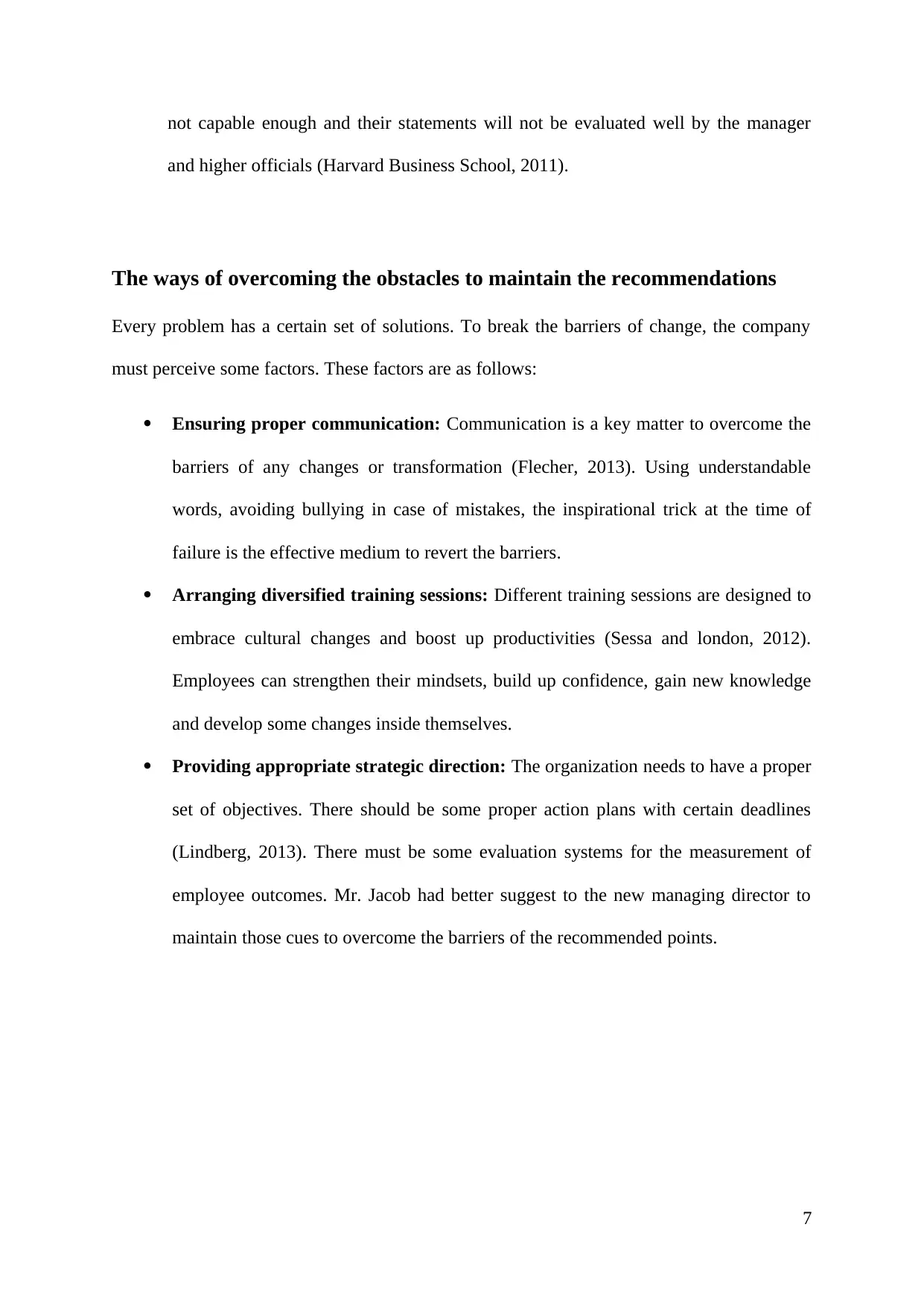
not capable enough and their statements will not be evaluated well by the manager
and higher officials (Harvard Business School, 2011).
The ways of overcoming the obstacles to maintain the recommendations
Every problem has a certain set of solutions. To break the barriers of change, the company
must perceive some factors. These factors are as follows:
Ensuring proper communication: Communication is a key matter to overcome the
barriers of any changes or transformation (Flecher, 2013). Using understandable
words, avoiding bullying in case of mistakes, the inspirational trick at the time of
failure is the effective medium to revert the barriers.
Arranging diversified training sessions: Different training sessions are designed to
embrace cultural changes and boost up productivities (Sessa and london, 2012).
Employees can strengthen their mindsets, build up confidence, gain new knowledge
and develop some changes inside themselves.
Providing appropriate strategic direction: The organization needs to have a proper
set of objectives. There should be some proper action plans with certain deadlines
(Lindberg, 2013). There must be some evaluation systems for the measurement of
employee outcomes. Mr. Jacob had better suggest to the new managing director to
maintain those cues to overcome the barriers of the recommended points.
7
and higher officials (Harvard Business School, 2011).
The ways of overcoming the obstacles to maintain the recommendations
Every problem has a certain set of solutions. To break the barriers of change, the company
must perceive some factors. These factors are as follows:
Ensuring proper communication: Communication is a key matter to overcome the
barriers of any changes or transformation (Flecher, 2013). Using understandable
words, avoiding bullying in case of mistakes, the inspirational trick at the time of
failure is the effective medium to revert the barriers.
Arranging diversified training sessions: Different training sessions are designed to
embrace cultural changes and boost up productivities (Sessa and london, 2012).
Employees can strengthen their mindsets, build up confidence, gain new knowledge
and develop some changes inside themselves.
Providing appropriate strategic direction: The organization needs to have a proper
set of objectives. There should be some proper action plans with certain deadlines
(Lindberg, 2013). There must be some evaluation systems for the measurement of
employee outcomes. Mr. Jacob had better suggest to the new managing director to
maintain those cues to overcome the barriers of the recommended points.
7
Paraphrase This Document
Need a fresh take? Get an instant paraphrase of this document with our AI Paraphraser
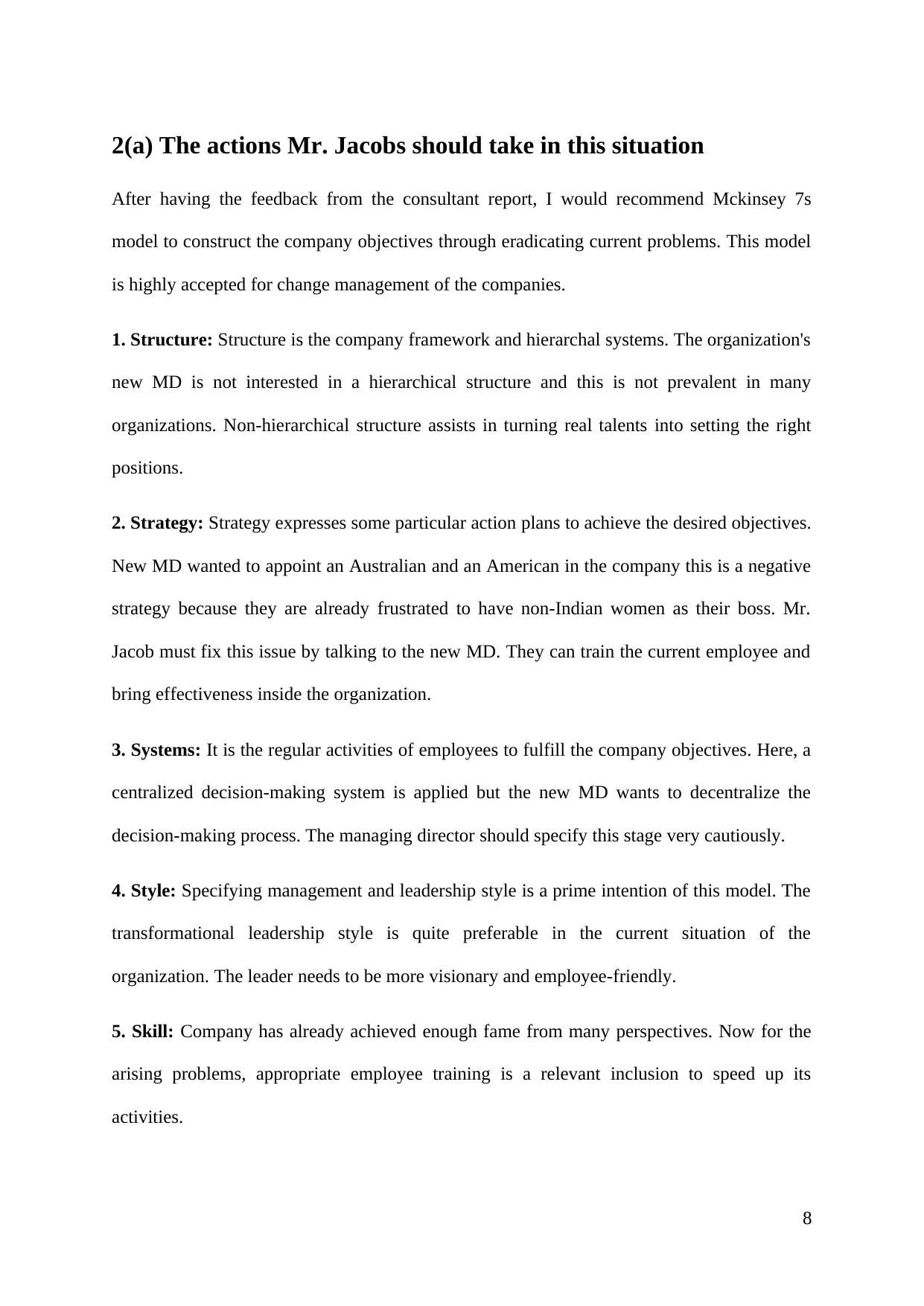
2(a) The actions Mr. Jacobs should take in this situation
After having the feedback from the consultant report, I would recommend Mckinsey 7s
model to construct the company objectives through eradicating current problems. This model
is highly accepted for change management of the companies.
1. Structure: Structure is the company framework and hierarchal systems. The organization's
new MD is not interested in a hierarchical structure and this is not prevalent in many
organizations. Non-hierarchical structure assists in turning real talents into setting the right
positions.
2. Strategy: Strategy expresses some particular action plans to achieve the desired objectives.
New MD wanted to appoint an Australian and an American in the company this is a negative
strategy because they are already frustrated to have non-Indian women as their boss. Mr.
Jacob must fix this issue by talking to the new MD. They can train the current employee and
bring effectiveness inside the organization.
3. Systems: It is the regular activities of employees to fulfill the company objectives. Here, a
centralized decision-making system is applied but the new MD wants to decentralize the
decision-making process. The managing director should specify this stage very cautiously.
4. Style: Specifying management and leadership style is a prime intention of this model. The
transformational leadership style is quite preferable in the current situation of the
organization. The leader needs to be more visionary and employee-friendly.
5. Skill: Company has already achieved enough fame from many perspectives. Now for the
arising problems, appropriate employee training is a relevant inclusion to speed up its
activities.
8
After having the feedback from the consultant report, I would recommend Mckinsey 7s
model to construct the company objectives through eradicating current problems. This model
is highly accepted for change management of the companies.
1. Structure: Structure is the company framework and hierarchal systems. The organization's
new MD is not interested in a hierarchical structure and this is not prevalent in many
organizations. Non-hierarchical structure assists in turning real talents into setting the right
positions.
2. Strategy: Strategy expresses some particular action plans to achieve the desired objectives.
New MD wanted to appoint an Australian and an American in the company this is a negative
strategy because they are already frustrated to have non-Indian women as their boss. Mr.
Jacob must fix this issue by talking to the new MD. They can train the current employee and
bring effectiveness inside the organization.
3. Systems: It is the regular activities of employees to fulfill the company objectives. Here, a
centralized decision-making system is applied but the new MD wants to decentralize the
decision-making process. The managing director should specify this stage very cautiously.
4. Style: Specifying management and leadership style is a prime intention of this model. The
transformational leadership style is quite preferable in the current situation of the
organization. The leader needs to be more visionary and employee-friendly.
5. Skill: Company has already achieved enough fame from many perspectives. Now for the
arising problems, appropriate employee training is a relevant inclusion to speed up its
activities.
8
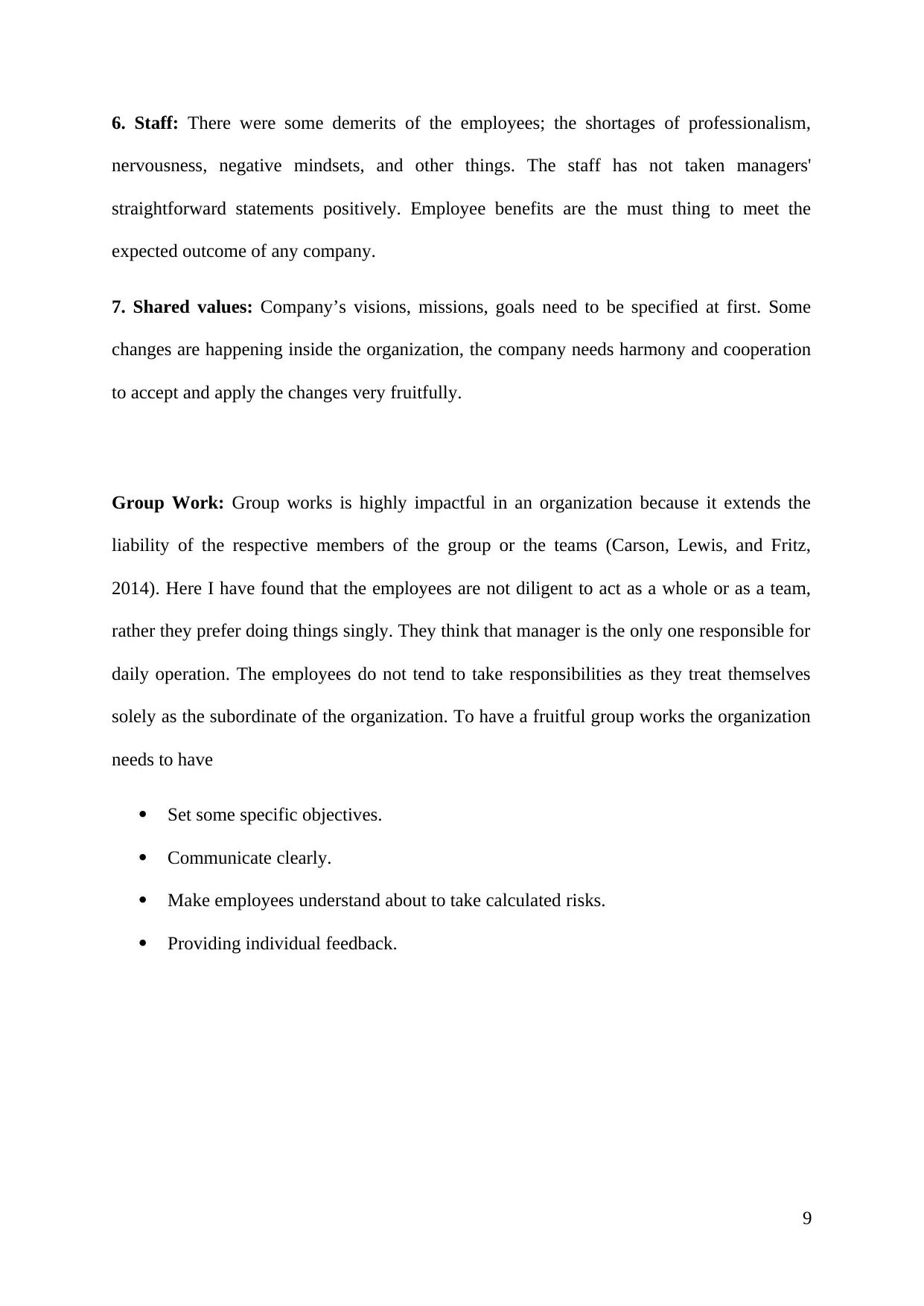
6. Staff: There were some demerits of the employees; the shortages of professionalism,
nervousness, negative mindsets, and other things. The staff has not taken managers'
straightforward statements positively. Employee benefits are the must thing to meet the
expected outcome of any company.
7. Shared values: Company’s visions, missions, goals need to be specified at first. Some
changes are happening inside the organization, the company needs harmony and cooperation
to accept and apply the changes very fruitfully.
Group Work: Group works is highly impactful in an organization because it extends the
liability of the respective members of the group or the teams (Carson, Lewis, and Fritz,
2014). Here I have found that the employees are not diligent to act as a whole or as a team,
rather they prefer doing things singly. They think that manager is the only one responsible for
daily operation. The employees do not tend to take responsibilities as they treat themselves
solely as the subordinate of the organization. To have a fruitful group works the organization
needs to have
Set some specific objectives.
Communicate clearly.
Make employees understand about to take calculated risks.
Providing individual feedback.
9
nervousness, negative mindsets, and other things. The staff has not taken managers'
straightforward statements positively. Employee benefits are the must thing to meet the
expected outcome of any company.
7. Shared values: Company’s visions, missions, goals need to be specified at first. Some
changes are happening inside the organization, the company needs harmony and cooperation
to accept and apply the changes very fruitfully.
Group Work: Group works is highly impactful in an organization because it extends the
liability of the respective members of the group or the teams (Carson, Lewis, and Fritz,
2014). Here I have found that the employees are not diligent to act as a whole or as a team,
rather they prefer doing things singly. They think that manager is the only one responsible for
daily operation. The employees do not tend to take responsibilities as they treat themselves
solely as the subordinate of the organization. To have a fruitful group works the organization
needs to have
Set some specific objectives.
Communicate clearly.
Make employees understand about to take calculated risks.
Providing individual feedback.
9
⊘ This is a preview!⊘
Do you want full access?
Subscribe today to unlock all pages.

Trusted by 1+ million students worldwide
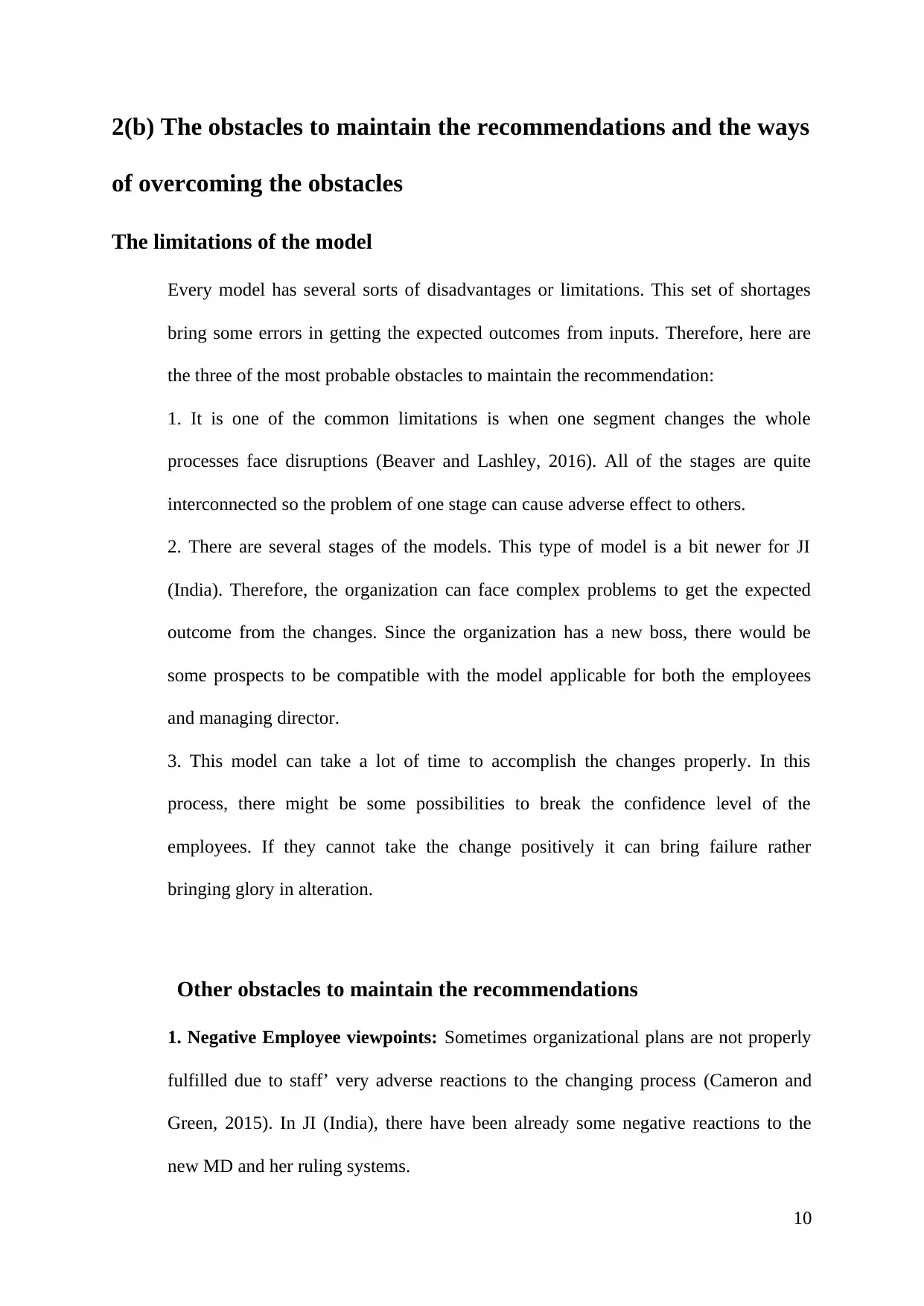
2(b) The obstacles to maintain the recommendations and the ways
of overcoming the obstacles
The limitations of the model
Every model has several sorts of disadvantages or limitations. This set of shortages
bring some errors in getting the expected outcomes from inputs. Therefore, here are
the three of the most probable obstacles to maintain the recommendation:
1. It is one of the common limitations is when one segment changes the whole
processes face disruptions (Beaver and Lashley, 2016). All of the stages are quite
interconnected so the problem of one stage can cause adverse effect to others.
2. There are several stages of the models. This type of model is a bit newer for JI
(India). Therefore, the organization can face complex problems to get the expected
outcome from the changes. Since the organization has a new boss, there would be
some prospects to be compatible with the model applicable for both the employees
and managing director.
3. This model can take a lot of time to accomplish the changes properly. In this
process, there might be some possibilities to break the confidence level of the
employees. If they cannot take the change positively it can bring failure rather
bringing glory in alteration.
Other obstacles to maintain the recommendations
1. Negative Employee viewpoints: Sometimes organizational plans are not properly
fulfilled due to staff’ very adverse reactions to the changing process (Cameron and
Green, 2015). In JI (India), there have been already some negative reactions to the
new MD and her ruling systems.
10
of overcoming the obstacles
The limitations of the model
Every model has several sorts of disadvantages or limitations. This set of shortages
bring some errors in getting the expected outcomes from inputs. Therefore, here are
the three of the most probable obstacles to maintain the recommendation:
1. It is one of the common limitations is when one segment changes the whole
processes face disruptions (Beaver and Lashley, 2016). All of the stages are quite
interconnected so the problem of one stage can cause adverse effect to others.
2. There are several stages of the models. This type of model is a bit newer for JI
(India). Therefore, the organization can face complex problems to get the expected
outcome from the changes. Since the organization has a new boss, there would be
some prospects to be compatible with the model applicable for both the employees
and managing director.
3. This model can take a lot of time to accomplish the changes properly. In this
process, there might be some possibilities to break the confidence level of the
employees. If they cannot take the change positively it can bring failure rather
bringing glory in alteration.
Other obstacles to maintain the recommendations
1. Negative Employee viewpoints: Sometimes organizational plans are not properly
fulfilled due to staff’ very adverse reactions to the changing process (Cameron and
Green, 2015). In JI (India), there have been already some negative reactions to the
new MD and her ruling systems.
10
Paraphrase This Document
Need a fresh take? Get an instant paraphrase of this document with our AI Paraphraser
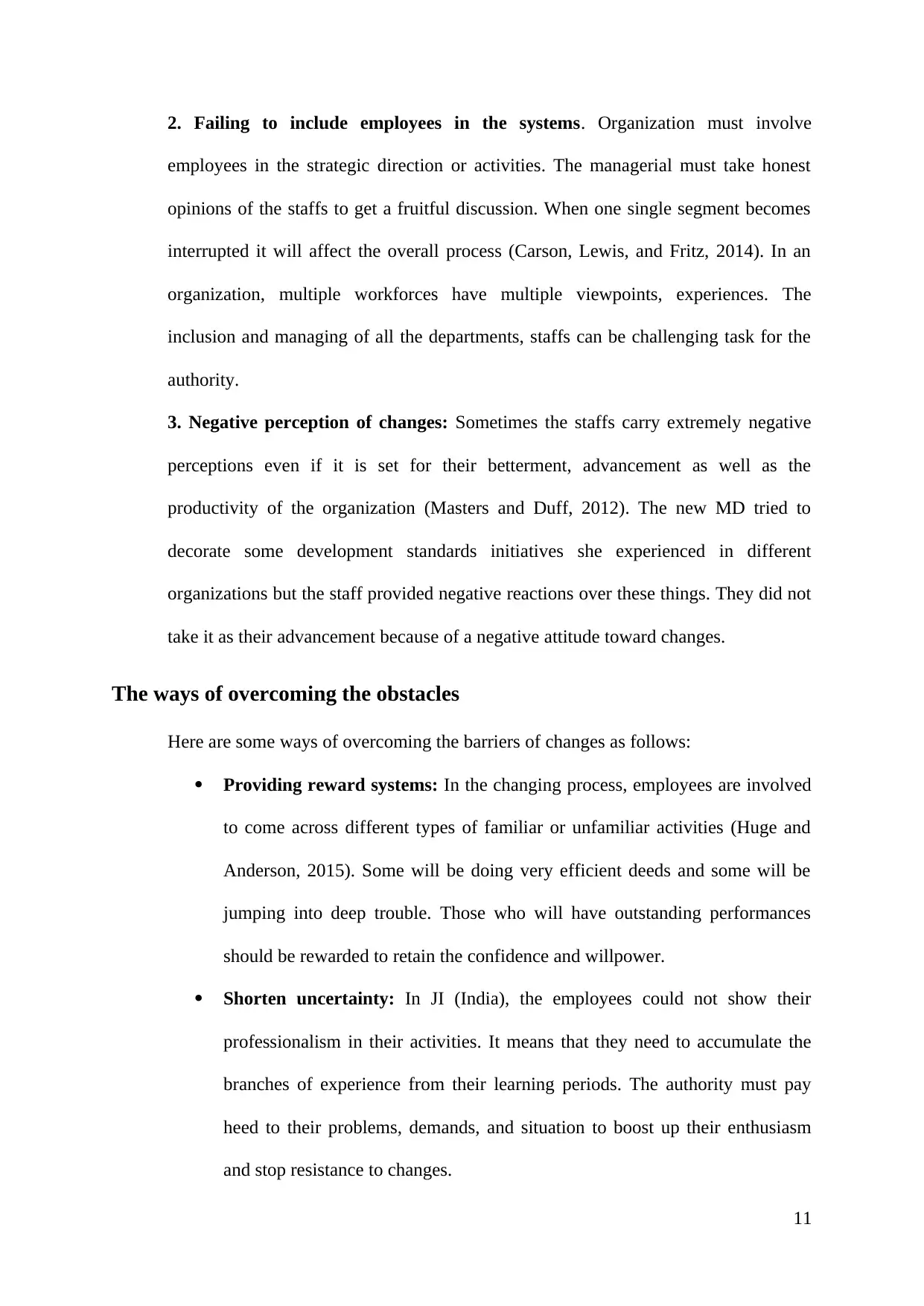
2. Failing to include employees in the systems. Organization must involve
employees in the strategic direction or activities. The managerial must take honest
opinions of the staffs to get a fruitful discussion. When one single segment becomes
interrupted it will affect the overall process (Carson, Lewis, and Fritz, 2014). In an
organization, multiple workforces have multiple viewpoints, experiences. The
inclusion and managing of all the departments, staffs can be challenging task for the
authority.
3. Negative perception of changes: Sometimes the staffs carry extremely negative
perceptions even if it is set for their betterment, advancement as well as the
productivity of the organization (Masters and Duff, 2012). The new MD tried to
decorate some development standards initiatives she experienced in different
organizations but the staff provided negative reactions over these things. They did not
take it as their advancement because of a negative attitude toward changes.
The ways of overcoming the obstacles
Here are some ways of overcoming the barriers of changes as follows:
Providing reward systems: In the changing process, employees are involved
to come across different types of familiar or unfamiliar activities (Huge and
Anderson, 2015). Some will be doing very efficient deeds and some will be
jumping into deep trouble. Those who will have outstanding performances
should be rewarded to retain the confidence and willpower.
Shorten uncertainty: In JI (India), the employees could not show their
professionalism in their activities. It means that they need to accumulate the
branches of experience from their learning periods. The authority must pay
heed to their problems, demands, and situation to boost up their enthusiasm
and stop resistance to changes.
11
employees in the strategic direction or activities. The managerial must take honest
opinions of the staffs to get a fruitful discussion. When one single segment becomes
interrupted it will affect the overall process (Carson, Lewis, and Fritz, 2014). In an
organization, multiple workforces have multiple viewpoints, experiences. The
inclusion and managing of all the departments, staffs can be challenging task for the
authority.
3. Negative perception of changes: Sometimes the staffs carry extremely negative
perceptions even if it is set for their betterment, advancement as well as the
productivity of the organization (Masters and Duff, 2012). The new MD tried to
decorate some development standards initiatives she experienced in different
organizations but the staff provided negative reactions over these things. They did not
take it as their advancement because of a negative attitude toward changes.
The ways of overcoming the obstacles
Here are some ways of overcoming the barriers of changes as follows:
Providing reward systems: In the changing process, employees are involved
to come across different types of familiar or unfamiliar activities (Huge and
Anderson, 2015). Some will be doing very efficient deeds and some will be
jumping into deep trouble. Those who will have outstanding performances
should be rewarded to retain the confidence and willpower.
Shorten uncertainty: In JI (India), the employees could not show their
professionalism in their activities. It means that they need to accumulate the
branches of experience from their learning periods. The authority must pay
heed to their problems, demands, and situation to boost up their enthusiasm
and stop resistance to changes.
11
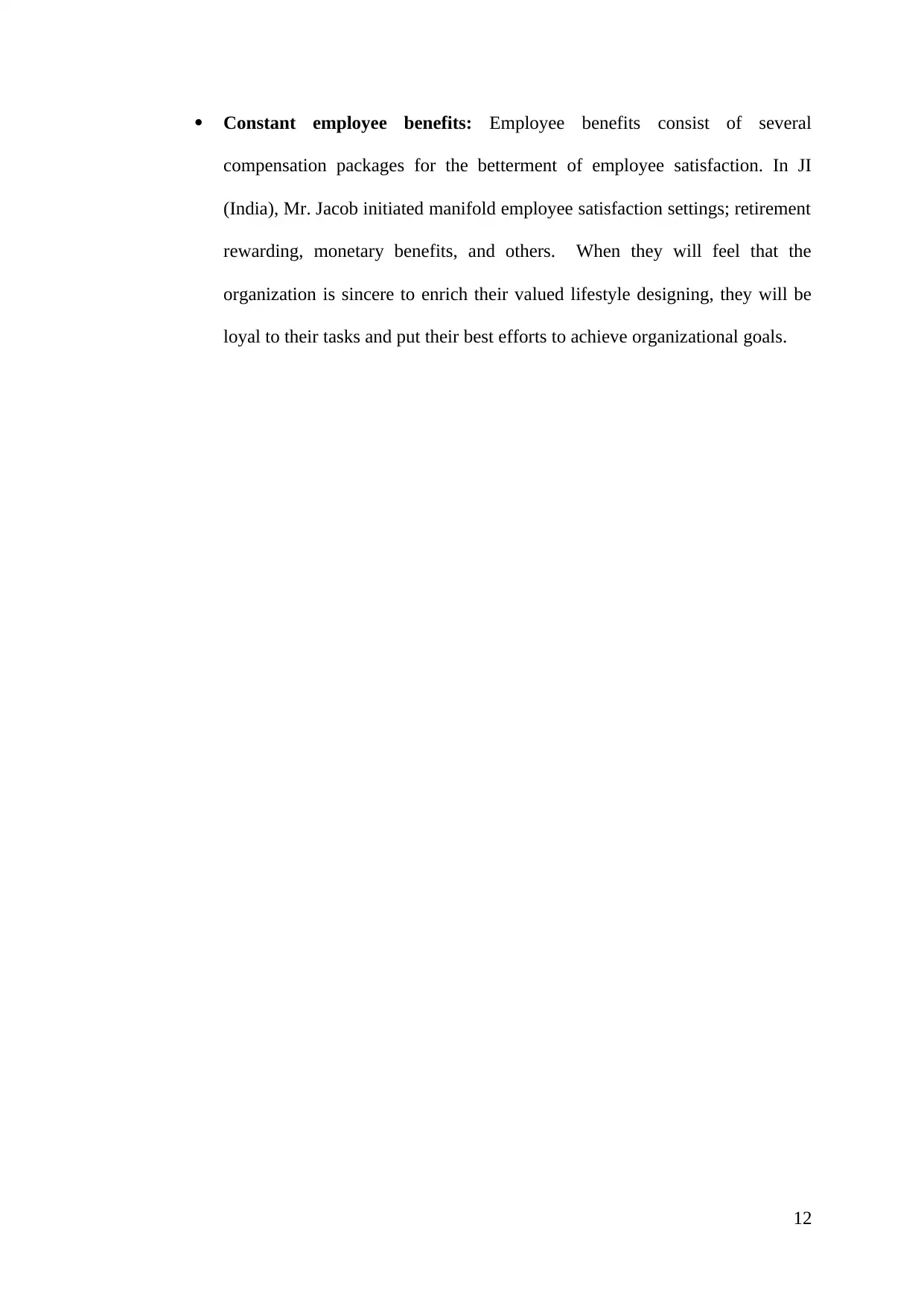
Constant employee benefits: Employee benefits consist of several
compensation packages for the betterment of employee satisfaction. In JI
(India), Mr. Jacob initiated manifold employee satisfaction settings; retirement
rewarding, monetary benefits, and others. When they will feel that the
organization is sincere to enrich their valued lifestyle designing, they will be
loyal to their tasks and put their best efforts to achieve organizational goals.
12
compensation packages for the betterment of employee satisfaction. In JI
(India), Mr. Jacob initiated manifold employee satisfaction settings; retirement
rewarding, monetary benefits, and others. When they will feel that the
organization is sincere to enrich their valued lifestyle designing, they will be
loyal to their tasks and put their best efforts to achieve organizational goals.
12
⊘ This is a preview!⊘
Do you want full access?
Subscribe today to unlock all pages.

Trusted by 1+ million students worldwide
1 out of 18
Related Documents
Your All-in-One AI-Powered Toolkit for Academic Success.
+13062052269
info@desklib.com
Available 24*7 on WhatsApp / Email
![[object Object]](/_next/static/media/star-bottom.7253800d.svg)
Unlock your academic potential
Copyright © 2020–2025 A2Z Services. All Rights Reserved. Developed and managed by ZUCOL.




